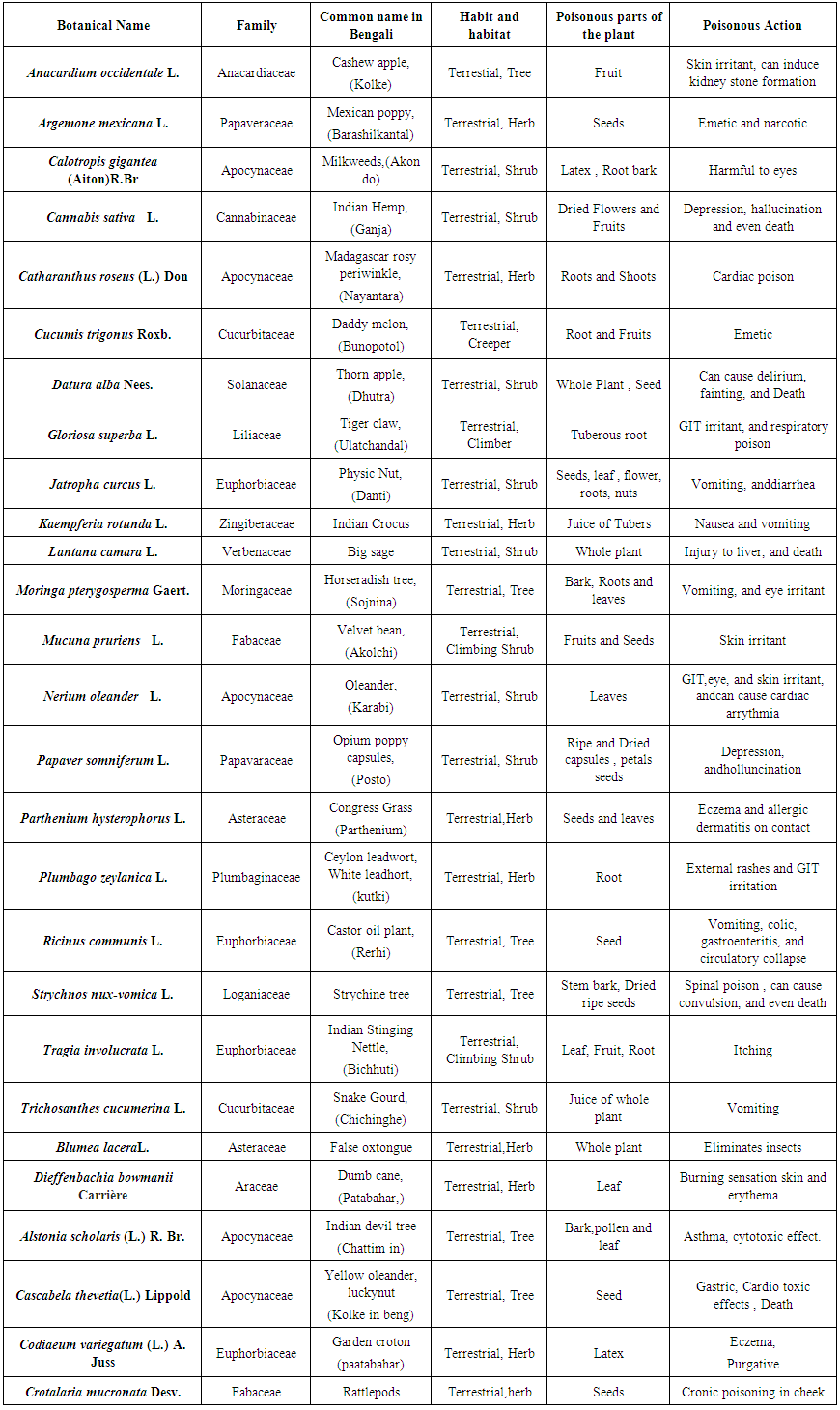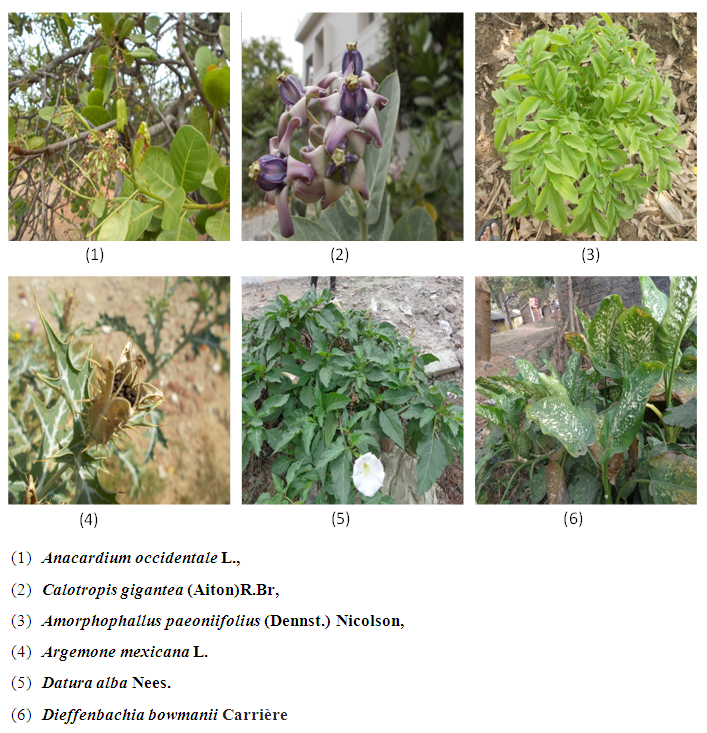-
Paper Information
- Paper Submission
-
Journal Information
- About This Journal
- Editorial Board
- Current Issue
- Archive
- Author Guidelines
- Contact Us
International Journal of Plant Research
p-ISSN: 2163-2596 e-ISSN: 2163-260X
2015; 5(5): 103-106
doi:10.5923/j.plant.20150505.02
Survey of Common Poisonous Plants of Birbhum, Burdwan, and Nadia Districts of West Bengal, India
Arindam Sikdar1, Amit Kumar Mondal2, Kumar Rajan3, Naveen Tripathi1
1Department of Biological Sciences, Indian Institute of Science Education and Research Kolkata, West Bengal, India
2Department of Zoology (Centre for Advanced Studies), Visva-Bharati University, Santiniketan, West Bengal, India
3Environmental Science School of Earth Biological and Environmental Sciences, Central University of South Bihar, BIT Campus Patna, Bihar, India
Correspondence to: Naveen Tripathi, Department of Biological Sciences, Indian Institute of Science Education and Research Kolkata, West Bengal, India.
| Email: |  |
Copyright © 2015 Scientific & Academic Publishing. All Rights Reserved.
Poisonous plants can be of immense economic importance. Several poisonous plants can be a source of medicines. Research on poisonous plants of East India is largely missing. With paucity of information about poisonous plants in West Bengal, India, we conducted a survey of common local plants, such that they can be later utilized for economic purposes. The survey of tribal villages in 3 districts of West Bengal resulted in identification of 27 poisonous plants that are presented in the paper.
Keywords: Poisonous plants, Poisonous action, Constituents, Birbhum, Burdwan, Nadia
Cite this paper: Arindam Sikdar, Amit Kumar Mondal, Kumar Rajan, Naveen Tripathi, Survey of Common Poisonous Plants of Birbhum, Burdwan, and Nadia Districts of West Bengal, India, International Journal of Plant Research, Vol. 5 No. 5, 2015, pp. 103-106. doi: 10.5923/j.plant.20150505.02.
Article Outline
1. Introduction
- The knowledge of poisonous plants in all over the world is useful for two main reasons. Firstly, the concern for humans and animals health due to its consumption and secondly, poisonous plants present a potential source for discovery of novel medicines. Plant poisons usually are mixture of different compounds and eventual isolation of the individual components was the driving motivation for this study.
2. Materials and Methods
- The study area included regions of Nadia, Birbhum and Bardhaman. We specifically targeted tribal villages for this work. The climate of these regions is tropical savanna and sub-tropical in nature. Plants were identified, photographed and collected. The collected specimen were dried and preserved in the herbarium sheet after spraying 0.2% mercuric chloride. Our survey relied on detailed conversations and field observations. An average interview with village elders in the tribal villages lasted around 15 minutes.
3. Results
- The survey lasted 4 months. Several plants encountered in one village were also found in another village. All these plants were common to all the three districts that were studied. Although few supposedly active ingredients have been identified in these plants, we ignored their mention as none of them have been established to be the main active ingredient or even causal to symptoms of poisoning. The plants encountered in our survey are arranged alphabetically in a tabular form in table 1. Figure 1 shows pictures of some of the common poisonous plants encountered in this study.
 | Table 1. List of poisonous plants surveyed in the survey of tribal villages of Nadia, Birbhum and Bardhaman |
 | Figure 1. |
4. Conclusions and Discussion
- The poisonous plants of India have been described (Jain 1991, 1999; Caius 2003) before but specific examination of the three districts of West Bengal, explored in this study, has not been conducted. In contrast, Rajasthan has witnessed extensive survey of plants, including poisonous plants (Bahndari, 1978; Shetty and Singh, 1993; Joshi, 1995; Singh and Pandey, 1998; Katewa et al, 2001; Katewa et al, 2003; Katewa et al, 2004; Katewa et al, 2006; Jain et al, 2004; Jain et al, 2005; Katewa and Galav, 2005; 2006). Our study is the first of its kind to start exploring the poisonous plants of this region. We expect detailed quantitative studies that are exhaustive in nature to follow this. We also expect a thrust in the area of isolation of active ingredients from these plants.
ACKNOWLEDGEMENTS
- This research was supported by Visva Bharati and IISER-K. We are thankful to Prof. Sudhendu Mandal, and Prof. Subrata Mondal. Salary of personal involved in this research was paid partly by the funds of Dr. Sukant Khurana at IISER-K. We would like to acknowledge Nabajit Das, visiting scientist at the Department of Biological Sciences (DBS), IISER Kolkata for his valued feedback on the manuscript and making the paper to publishing.
 Abstract
Abstract Reference
Reference Full-Text PDF
Full-Text PDF Full-text HTML
Full-text HTML